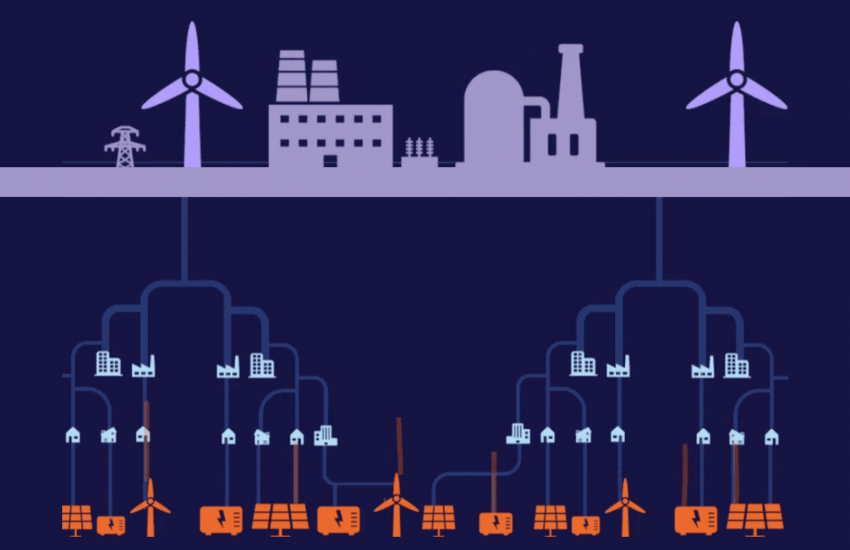The terms sustainable and renewable energies have become buzzwords in a common man’s life. From large multinational industries to common households, people are looking for eco-friendly alternatives to fossil fuels to reduce carbon emissions and conserve the environment. The Paris agreement was a landmark in the multilateral climate change process, and it set guidelines to avoid dangerous climate change by limiting global warming to well below 2°C (3.6°F) and pursuing efforts to limit it to 1.5°C (2.5°F). More and more organizations are starting to realize the importance of sustainability and are shifting towards renewable and clean sources to meet their energy needs.
Blockchain technology could be the future of renewable energy and a new chapter in smart technology. Although it has created the most buzz in the financial services industry, the network infrastructure of the energy industry makes it particularly suitable for blockchain technology applications. Given its potential impact on every industry, from finance to healthcare, it’s no surprise that blockchain is one of the most exciting developments in recent years. But what does this have to do with renewables? Read on to find out how blockchain technology could positively impact green energy adoption and why it is vital in doing so.
What makes blockchain suitable for the energy sector?
A blockchain is a decentralized, distributed ledger that can be applied to track and trace a range of transactions, assets, and commodities. It is a type of distributed ledger that enables parties to track the transaction progress and settle it with ease while keeping the details of the transaction private. Blockchain is often used in reference to cryptocurrencies, but it is not just one technology. In fact, there are many different types of blockchains.
Each blockchain is made up of nodes, and these nodes are connected to form a network. The distributed nature of blockchain ledgers makes them highly resistant to data modification. The data can only be modified if all the nodes in the network approve the change. This makes it an ideal technology for use in critical environments, such as power and utility networks. By using blockchain, we can track and trace electricity from the point of generation, through transmission networks and distribution networks, to the point of sale or use-allowing all parties involved to track the progress of the energy.
How will blockchain transform the renewable energy industry?
Track and trace renewable energy
The track and trace functionality is particularly promising for the renewable energy sector. As the use of clean energy keeps growing, the sector is being increasingly targeted by fraudsters who misreport or misallocate clean power to inflate their generation numbers. This can be combated by tracking renewable energy from the point of generation through the transmission network, and to the point of sale or use. By using blockchain to track energy, it can be verified as a legitimate source of power. Allowing all parties involved to track the progress of the energy can help with allocating clean energy and avoiding fraudulent practices, such as double counting or misallocation of energy. Higher visibility into the end-to-end process of energy production, transmission, and distribution can also allow for optimization of the entire value chain and provide more insight into operational efficiencies.
Automating processes
The use of blockchain platforms and smart contracts in the energy sector can allow for the automation and optimization of processes, such as switching between different energy sources. This can be done by linking the system to the weather forecast and other data sources to forecast demand and trigger the necessary changes. By integrating these systems with the wider grid, it’s possible to forecast and offset the high demand for electricity by switching to a renewable energy source and triggering the switch back to a fossil fuel source later. This process can be automated by using blockchain and smart contracts. The immense potential of blockchain-based smart contracts has been explored by many energy companies to improve the procurement and installation processes of the energy grid.
Peer-to-peer trading in the renewable energy sector
Peer-to-peer trading is a key feature of distributed ledger technology and can be leveraged by renewable energy producers to sell their excess energy directly to households or other customers. This enables households to generate their own power supply, which will act as a backup in case the main source of electricity fails. By using blockchain, the energy exchange can be recorded, verified, and settled instantly. It can also be automated, allowing for real-time price discovery and immediate execution without the need for a central authority. This will lower transaction costs and improve the cash flow of renewable energy producers as the transaction can be settled immediately.
The benefits of blockchain-enabled solutions can also be used on Renewable Energy Certificate (REC) exchange platforms. The blockchain technology allows energy producers to earn more by issuing energy tokens that can be consumed or resold, creating a clean and multi-dimensional grid. In this way, blockchain technology builds a decentralized energy-sharing economy in which energy can be exchanged between nodes, stabilizing the network.
Blockchain-based microgrids
Energy companies and renewable energy producers can also harness blockchain technology to build microgrids, which are small-scale grids that are largely independent of the main grid. This is done by linking a distributed ledger to the technology that controls the microgrid, such as an inverter or a smart meter. By leveraging blockchain within a microgrid, it can be operated autonomously and be more efficient than a larger grid. It can also act as a fallback system in case of an outage in the main grid by providing energy to the closest customers. By allowing the microgrid to operate autonomously, it can be more efficient and cost-effective while also providing a secure and more reliable energy source.
Payments and settlements in the renewable energy space
Blockchain technology enables peer-to-peer payments between producers and consumers of renewable energy, providing a more seamless experience that is less reliant on third-party support. Billing and payments for customers and distributed generators can be automated with smart contracts. This can help to reduce transaction costs and speed up the process of making payments for clean energy, as it does not have to go through third parties such as a utility or an online marketplace. Moreover, blockchain can provide a more secure and transparent record of transactions, which can help to increase trust between the parties. This is particularly important in the energy space, where many stakeholders need to collaborate and agree on certain terms. For example, if you have rooftop solar panels, you may want to feed your excess energy into the grid. But you will need to negotiate with your utility company to get paid for that energy.
Conclusion
Renewable energy is not just a trend. It is a crucial step in the direction of a cleaner planet. As more people become concerned about climate change, clean energy sources like solar, hydroelectric, and wind continue to gain popularity. And as demand for renewable energy continues to grow, so does our need for more innovative solutions that can help us meet this demand responsibly and sustainably.
However, employing renewable energy has its own challenges. The decentralized nature of these energy sources makes them difficult to monitor and audit effectively. In addition, there are regulatory issues regarding ownership and transmission that must be considered before implementing any of these systems on a wide scale. As a result, blockchain technology might be the remedy formula to many of these problems that come with using renewable energy sources. By leveraging blockchain technology, energy companies can improve their processes and increase efficiency, while also reducing costs. Moreover, blockchain can also help to facilitate trust and create a more secure environment for peer-to-peer energy trading.

